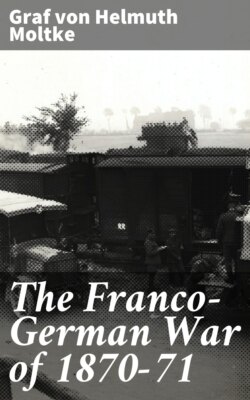Читать книгу The Franco-German War of 1870-71 - Graf von Helmuth Moltke - Страница 20
На сайте Литреса книга снята с продажи.
New Distribution of the Army.
ОглавлениеTable of Contents
The siege of Metz had formed no part of the original plan of campaign; it had been intended to do no more than merely to maintain an observation on the place when the main army should have passed it on the advance towards Paris; and a Reserve Division, consisting of eighteen battalions, sixteen squadrons, and thirty-six guns, detailed for that duty, was now near at hand.
Under the altered conditions, however, the regular investment of Metz was now necessary, and this involved a radical alteration of the existing arrangements throughout the whole army.
A separate army under the command of Prince Frederick Charles, consisting of the Ist, VIIth, and VIIIth Corps of the former Ist Army, the IInd, IIIrd, IXth, and Xth Corps of the IInd Army, the Reserve Division and the 1st and 3rd Cavalry Divisions, in all 150,000 men, was assigned to the duty of investing Metz.
The Guard, IVth, and XIIth Corps and the 5th and 6th Cavalry Divisions were formed into a separate army under the command of the Crown Prince of Saxony; it was styled "The Army of the Meuse" and was 138,000 strong.[17] This and the IIIrd Army, which numbered 223,000 men, were directed to advance against the new French army forming at Châlons.
Certainly the army investing Metz was left weaker than the blockaded enemy. It was to be expected that the latter would renew his efforts to break out to the westward. Prince Frederick Charles' main forces were therefore to remain on the left bank of the Moselle.
All these orders received the approval of the King, and were dispatched to the commanding officers by eleven o'clock on the morning of the 19th.
In accordance with the orders of Prince Frederick Charles, the Xth Corps occupied the woodland districts of the lower Moselle as far as St. Privat, while the IInd held the high ridge from that point to Moscou. To the right of the IInd, the VIIIth and VIIth Corps followed on, the latter positioned on both sides of the Upper Moselle. The Ist Corps occupied the Pouilly upland to left and right of the Seille, specially charged to protect the great magazines which were being established at Remilly and Pont à Mousson. The 3rd Reserve Division moved to the vicinity of Retonfay, north-east of Metz. The IXth and IIIrd Corps cantoned at St. Marie and Verneville as reserve. All the troops immediately set about the construction of earthworks, and of bridges over the Moselle above and below the fortress.
Of the Corps now belonging to the Army of the Meuse, the XIIth assembled at Conflans and the Guards at Mars la Tour; the IVth Corps, which had not been ordered to Metz, had already reached Commercy.
The IIIrd Army, after crossing the Vosges range, and having left a Bavarian brigade blockading Toul, was pressing forward in three columns. Its foremost Corps had already reached the Meuse, but were obliged to halt there for two days, so as to cross the river approximately abreast of the Meuse army. Its cavalry meanwhile patrolled three marches ahead as far as Châlons and Vitry, where, for the first time since Wörth, it regained touch of the enemy. The French encountered were only guarding posts on the Marne railway-line, which retired when the traffic thereon ceased.
